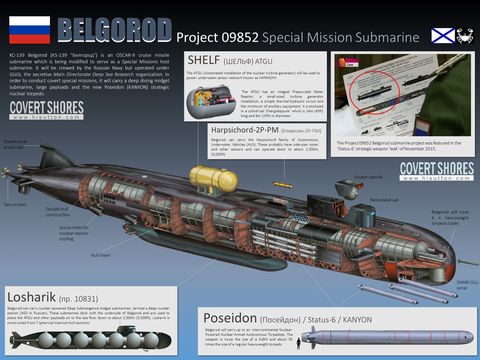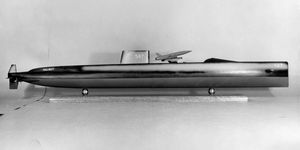Continuation of a compilation of material from open sources.First see:
Predicting Chinese submarine technology using Russian technology as a proxy in a Dempster Shafer framework-Part 1
and
Predicting Chinese submarine technology using Russian technology as a proxy in a Dempster Shafer framework-Part 2
Part 2 reported an article by Lyle J. Goldsteinwho wrote that China Is Studying Russia's Robot Submarines—and Is Building One of Their Own
Part3 follows on from Part 2, with this story about Russia's nuclear-capable underwater drone “Poseidon”, as reported in The Diplomat.
Russia’s Second Poseidon Underwater Drone-Carrying Submarine to Be Launched in 2020
The second Poseidon-carrying sub, the Project 09851 nuclear-powered special purpose submarine Khabarovsk, will be launched in the spring of 2020, according to Russian media reports.
It will be the Russian Navy’s second submarine capable of carrying the the nuclear-capable underwater drone “Poseidon,” alternatively referred to as an unmanned underwater vehicle (UUV), autonomous underwater vehicle (AUV), or simply an intercontinental-range, nuclear autonomous torpedo.
According to a Russian defense industry source quoted by TASS news agency, the new submarine is expected to be handed over to the Navy in 2022 and will be able to carry up to six Poseidon UUVs, also known under Ocean Multipurpose System Status-6 or “Kanyon” by the U.S. intelligence community.
It is still uncertain whether the Poseidon UUV will be solely deployed as a nuclear-warhead delivery platform or could be used for other purposes including intelligence, surveillance, and reconnaissance (ISR) missions. In total, the Russian Navy is slated to receive over 30 Poseidons with the first batch ready for operational deployment in the late 2020s.
The Khabarovsk is purportedly a downsized variant of the Borei-class of nuclear-powered ballistic missile submarines (SSBN). The Russian Navy currently deploys three Borei-class boomers. The Yuri Dolgoruky is in service with Russia’s Northern Fleet, while two other Borei-class SSBNs – Alexander Nevsky and Vladimir Monomakh — are deployed with the Russian Pacific Fleet.
Next to the Khabarovsk, the Poseidon will also be carried by the Project 09852 Special Mission Submarine KC-139 Belgorod, which was launched at the Sevmash Shipyard, located in Severodvinsk in northern Russia, on April 23. The submarine is based on the 949A Oscar II-class nuclear-powered guided missile submarine (SSGN) design.
As I wrote last month:
The submarine was laid down at the Sevmash Shipyard in July 1992 but its construction was suspended in 1997. Work on the unfinished 949A Oscar II-class SSGN began again in 2012 following a redesign of the sub undertaken by the Rubin Central Design Bureau in St. Petersburg as a special purpose submarine. With a reported lengths of 184 meters, the Belgorod is set to become the Russian Navy’s largest submarine by its length. (The sub has a reported displacement of around 15,000 tonnes when surfaced.)
The boat will be operated by the Main Directorate Deep Sea Research (GUGI) organization and will likely be deployed under the Arctic for covert special missions, which purportedly will include the installation of a Russian underwater sonar network.
In addition to the Khabarovsk and Belgorod, two more 949A Oscar II-class SSGNs are expected to be retrofitted to carry the Poseidon UUVs by the mid 2020s. Two of the subs are reportedly slated for service with the Northern Fleet, while the remaining two will be deployed by the Russian Pacific Fleet, according to a Russian defense industry source.
See also from Popular Mechanics
Russia Launches Belgorod, the World’s Longest Submarine
The Belgorod will carry out underwater spy missions and launch Poseidon nuclear torpedoes.
Russia launched the world’s longest submarine today, the special mission submarine Belgorod. Designed to support a variety of military missions, including the Poseidon long-range strategic nuclear torpedo, the sub is far larger than anything operated by any other naval force, including the U.S. Navy. The six hundred foot long submarine displaces more water than a World War I battleship and can dive to a depth of 1,700 feet.
The submarine was launched today, April 23rd, at the Sevmash shipyards in Russia, with Russian President Vladimir Putin reportedly watching via satellite.
Officially known as Project-09852, the submarine was originally an Oscar II-class cruise missile submarine that the Russian government ran of funds to complete. The submarine hull sat unfinished until Moscow decided to complete it as a special mission submarine.
The hull was lengthened to approximately 184 meters (604 feet) and the ship’s displacement ballooned to 30,000 tons submerged--more than fifty percent greater than the U.S. Navy’s Ohio-class ballistic missile submarines. The result of an unfinished hull the Belgorod is a one-off, and there will not be another one like it.
The nuclear-powered Belgorod is neither an attack submarine nor a ballistic missile sub. A special mission submarine, Belgorod will be a mothership to other undersea vessels. The sub can carry a payload on its back, behind the sail, or a Losharik class mini-submarine that attaches and detaches to the bottom of the hull.
According to HI Sutton, noted authority on undersea warfare, Belgorod will be crewed by the Russian Navy but operated by GUGI, the secretive Main Directorate Deep Sea Research organization. Sutton, who has been watching Belgorod’s development from afar, tells Popular Mechanics, “Belgorod was originally laid down as an Oscar-II class cruise missile submarine, but work stopped when the Russian economy caught up with the submarine building program. Work restarted years later in her modified form. So she is already older than many of her crew.”
“The modifications are likely to be extensive, and may include some latest technology, but underneath she is still an earlier generation of submarine, and likely to be less stealthy than the latest generation.”
Sutton’s observations from afar have largely been correct but he also warns some details will be wrong. “Russia has generally been more successful than the US at protecting her latest submarines from unwanted cameras,” Sutton explained. “Just this week documents allegedly leaked of a nuclear triad briefing for President Trump included a cutaway of the as-yet unbuilt Colombia class ballistic missile submarine. For Russia's latest boats we are still guessing many details.
“Defense observers can piece together a few sources and rumors with traditional analytical techniques to second guess what Belgorod is like. The cutaway (above) represents a best guess before any photos of Belgorod post-modifications emerged.”
One major mission Sutton believes Belgorod is meant for is the covert placement of the Harmony submarine detection network. A nuclear-powered underwater detection system, Harmony could help alert Russian forces of enemy submarines transiting through key areas. The key to their working however is their covert deployment, something Belgorod was practically built to do. Another mission is conducting covert operations with the Losharikmidget submarines. The 230 foot long, nuclear-powered Losharik is equipped with robotic arms and capable of diving to 1,000 meters (3,280 feet). The massive submarine will also be able to carry the Harpsichord-2P-PM autonomous underwater vehicle, transporting it to an operating area and then use its sonar to map the ocean floor or find man-made objects.
Although built to conduct underwater espionage, by far the most sinister mission for Belgorod is as launch vehicle for the Poseidon nuclear torpedo system. Poseidon is a very large torpedo, 65 feet long and 6.5 feet in diameter, with a range of thousands of miles and a top speed of 60 knots. Poseidon is believed to carry a 2 megaton thermonuclear warhead and is designed to go around U.S. missile defenses to strike coastal targets, including ports and cities. According to HI Sutton Belgorod will carry up to six Poseidon torpedoes.







No comments:
Post a Comment